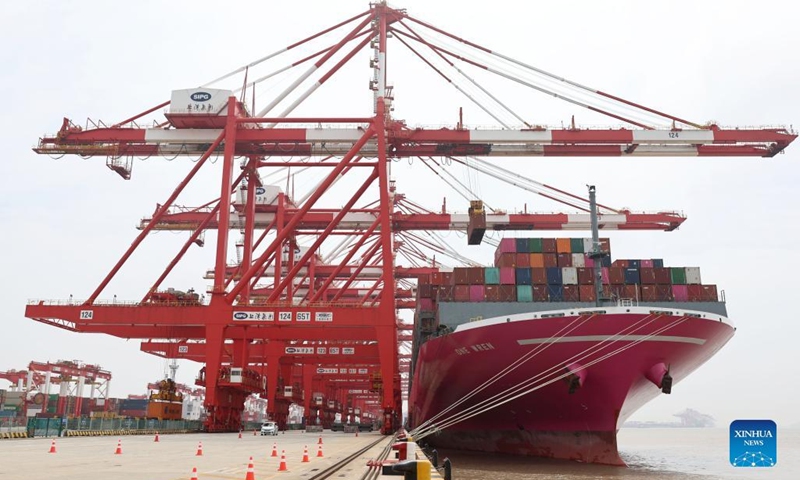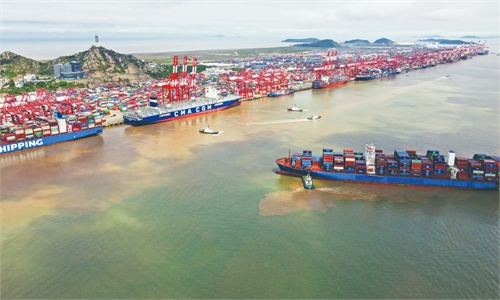US, allies eye exclusive supply chains despite soaring inflation; Politicized move hard to carry out as it pushes up prices, ‘against globalization’

A container ship from Japan is seen at the container dock of Shanghai's Yangshan Port in east China, April 27, 2022. About 25,000 staff members stick to their posts in Shanghai port to guarantee water transportation and improve logistics efficiency amid challenges caused by the recent resurgence of COVID-19 in Shanghai.(Photo: Xinhua)
From the launch of the Indo-Pacific Economic Framework for Prosperity (IPEF), to Janet Yellen's call for partnered efforts to boost supply chain resilience through so-called "friend-shoring", and to the signing of a joint statement on global supply chain cooperation with 17 partner economies during the Supply Chain Ministerial Forum, the US is ramping up efforts, even "kidnapping" some of its allies, to elbow out Chinese production from global supply chains, experts said.Such measures, which some observers say have the intention of shifting public focus away from the US' domestic problems, will be difficult to carry out in reality as they would not only push the already troubling inflation to an even worse level, but would also heavily disrupt the current global supply chain that has been formed through decades of globalization, they noted.
In a joint statement issued on Wednesday, the US and 17 ally economies including Japan, the EU and India agreed to work together to improve and diversify global supply chains. They agreed to follow four principles in global supply chains: transparency, diversification, security, sustainability, according to a statement published on US State Department website.
The statement also said that the countries intend to cooperate to eradicate the use of forced labor in global supply chains, while US officials also stressed during the forum that they aim to increase "friend-shoring" to move production of key supplies to allied nations.
Whether it's mentioning the so-called "forced labor" or holding a ministerial-level forum on supply chains that exclude China, the world's largest supplier, it is a reflection of the US strategy of cracking down on China - this time from the angle of supply chains, experts noted.
"The US has in recent years become wanton in using all its tricks to contain China's tech rise. Whether it is through grouping with its allies, setting up certain agendas or abusing legal clauses," Gao Shiwang, a director with the China Chamber of Commerce for Import and Export of Machinery and Electronic Products (CCCME), told the Global Times on Thursday.
Unfeasible in reality
According to experts, the US is saddling economic matters with political intentions, with a special focus on suppressing China's high-tech industries such as 5G, semiconductors and photovoltaic. This kind of mindset has given rise to a number of measures launched by the US to set up regional supply chain alliances without China.
In May, the Biden administration launched a major trade initiative called the Indo-Pacific Economic Framework (IPEF) with some allies, a move read by many as having the intention of expanding US economic leadership in the Indo-Pacific region to counter China.
Hu Qimu, chief research fellow at the Sinosteel Economic Research Institute, told the Global Times on Thursday that one intention of the Biden administration is to shift public attention away from US domestic problems, like the abortion controversy, ahead of the midterm elections.
"Biden is eager to build up a public image of someone who engages in strategic competition with China in order to win some votes from anti-China forces, at a time when US' economic and social problems are jeopardizing his approval rating," he said.
But this agenda is being pushed at the expense of US companies and American people's own interests with rising costs and further away from end markets, experts said, adding that it is unfeasible for it to be carried out in reality.
For one thing, analysts pointed out that the current global industry chain distribution is a result of some 40 years of globalization, and one that cannot be reversed easily in the short term by any government.
In particular, many countries are highly dependent on several core industries, such as the automobile industry in Japan and the electronics industry in South Korea. It's highly unlikely that those countries can be forced to strip the industrial chain they laid out in China to form a new, US-led industry pattern, Tian Yun, a veteran macro economist, told the Global Times on Thursday.
"What are offered by China in such a close industrial partnership, including talents, upstream and downstream supply chains, supporting business environment... can't be replaced just with money or political pressure," Tian said.
Hu also emphasized his view by saying that it's almost impossible to find substitutes for Chinese goods, particular parts or materials for high tech products, as they are cheaper than competing products in developed markets,
while emerging markets are often incapable of producing them due to lack of technologies, labor quality or supporting facilities.
The irreplaceable advantages of China's supply chains have also been proven by the domestic trade situation recently, as China's strong trade data despite adverse factors like US challenges and COVID-19 showed that the position of China's supply chains in global markets has not been beaten down, but augmented.
"It shows that the US is not only bad at tackling inflation, but has significant deviation in judging the development direction of global supply chains," Chen Jia, a research fellow at the International Monetary Institute of the Renmin University of China, told the Global Times.
China's trade surplus surged to a record high of $97.94 billion in June 2022, beating market forecasts and vividly illustrating China's exports momentum, Chinese customs data showed.
Costs to soar
Experts also noted that the repercussions of excluding China from global supply chains largely outweigh the impact that such moves will bring to China, as the country's reliance on foreign demand has been decreasing after the smooth running of internal circulation in recent years.
"The US-centric small circles that exclude the world's second-largest economy will only disrupt the natural flow of industrial chains and increase the cost of production, causing enterprises in the circle to lose their competitiveness and its customers to bear the high prices. It also stands on the opposite side of globalization," Gao Lingyun, an expert at the Chinese Academy of Social Sciences in Beijing, told the Global Times on Thursday.
Indeed, the negative impact of forsaking Chinese supplies has already been reflected in rising inflation in the US and other countries following the Trump administration's trade war tactic. According to former US ambassador David Adelman, removing tariffs on imported Chinese goods will strip 1 percent off inflation in the US, the CNBC reported.
According to Chen, the rising inflation in the US in recent years also demonstrates the Chinese supply chain system's contributions to stabilizing global trade, driving down inflation and improving people's life quality.
Chen also noted that if the US insists on excluding Chinese supplies, it would only have two repercussions in the short term: failure and further fragmentation of global supply chains.




